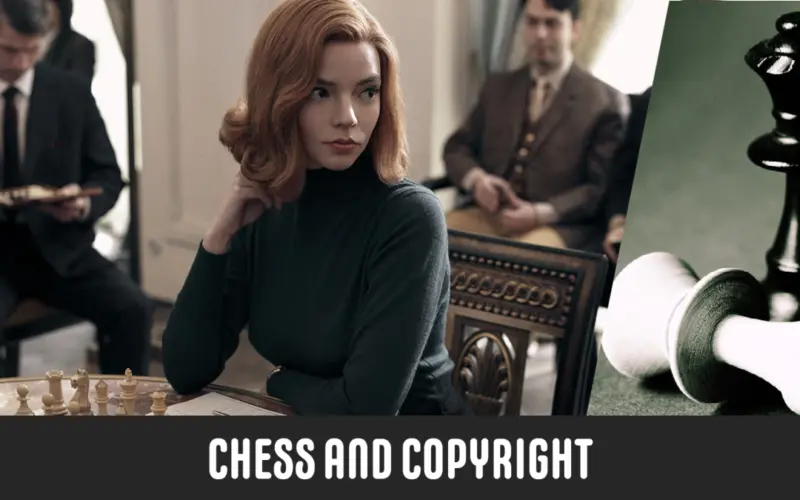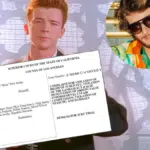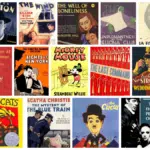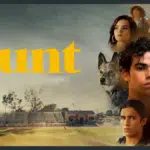“The Queen’s Gambit” has sparked a new wave of interest in chess. And while chess moves and game results aren’t protected by copyright law, that’s not for a lack of trying.
Chess is hot. That’s a not a sentence I ever thought I’d be writing, but 2020 has been nothing if not surprising. Unless you’ve been taking too many Librium pills, you know that the centuries-old game owes its newfound popularity almost entirely to “The Queen’s Gambit.” The filmed adaptation of Walter Tevis’ 1983 novel has already set a record as the most-watched scripted limited series in Netflix history. Over 62 million households tuned in during the program’s first month of release, a number that’s only going to increase throughout the long Thanksgiving weekend.
While viewers of “The Queen’s Gambit” may be coming for the lavish cinematography, the 1960’s fashion, and the sex appeal of star Anya Taylor-Joy, they seem to be staying for the chess. NPR reports that sales of chess sets and accessories are up by over 1000%, suddenly making them one of the hottest gifts of the year. And more than 100,000 people a day have been signing up to play on Chess.com, which is five times the site’s typical daily average.
This means that people around the world are likely trying to learn the various chess openings name-dropped in the Netflix film—from the namesake “Queen’s Gambit” to the “Najdorf Variation of the Sicilian Defence” to the “Levenfish Attack.” (As someone who was attacked by a levenfish last summer, I can confirm that one isn’t pretty). As new players continue to study and use the opening sequences developed by chess champions from over a century ago, it got me wondering whether anyone had ever tried to seek copyright protection in these moves or other aspects of chess gameplay.
Copyright Protection in Games
As an initial matter, it’s pretty clear, at least under U.S. copyright law, which aspects of a game are subject to copyright protection and which aren’t. Copyright does protect original pictorial, graphic or sculptural expression contained in a board game. This includes the game’s artwork and the original sculptural aspects of game pieces. The particular expression of the game rules can also be protected as a literary work. However, the actual rules of play, or “game mechanics,” aren’t subject to protection. This limitation stems from the fact that copyright protection doesn’t extend to ideas, procedures or processes.
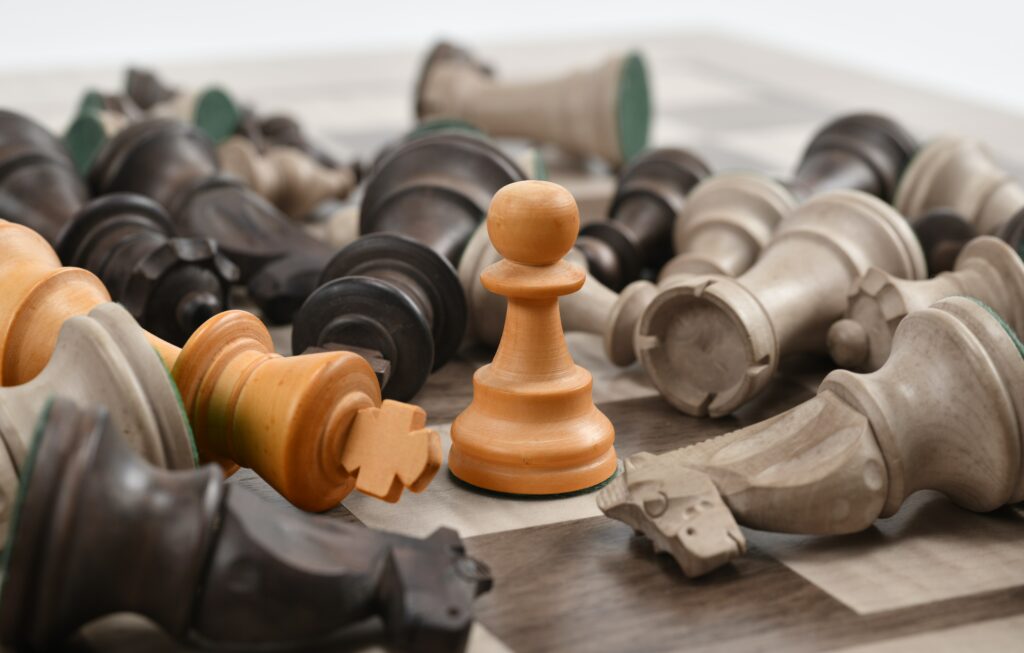
Early Attempts to Claim Ownership of Chess Game Results
Chess has been around for centuries, and no element of the game itself is subject to any sort of copyright protection. However, this hasn’t stopped tournament organizers and players from trying to claim rights in various aspects of play over the years. Renowned chess historian Edward Winter has chronicled some of the early attempts to assert restrictions on the publication of game results.
For example, in the very first international chess tournament in London in 1851, Rule 12 provided that because the recording and subsequent publication of copies of each whole game was conducted at “considerable expense” of the tournament’s managing committee, “it must be understood that no-one will be allowed, in the first instance, to publish any part of them without the express sanction of the committee.”
You may recognize this “considerable expense” argument as a variation of the “sweat of the brow” theory of copyright, in which the creator of a work claims protection, not based on originality or creativity, but on the effort expended in creation.
Sweat of the brow was firmly rejected by the U.S. Supreme Court in 1991’s Feist Publications v. Rural Telephone Service. However, English copyright law of the early twentieth century was generally more receptive to the theory, and chess tournament organizers would routinely enter into publication agreements with newspapers for game results.
German chess player Emanuel Lasker, who held the title of world champion for 27 years from 1894 to 1921, also made regular attempts to copyright his games. Below is a copy of a November 1911 article from New York’s Evening Post in the Library of Congress’ online newspaper database, which reported on the conditions under which Lasker would accept José Raúl Capablanca’s challenge for a title match:

Capablanca rejected Lasker’s demand:
A chess game, from its very nature and the manner of its production, must be the joint property of the two persons producing it …. You can charge what you like for the publication of the games in any form you may deem to your advantage. But, unfortunately, that is a common privilege, of which anyone may take advantage.
José Raúl Capablanca response to Lasker conditions, American Chess Bulletin, February 1912
Capablanca was correct in assessing that chess is a joint effort, insofar as one player’s moves are necessarily influenced by the moves of his or her opponent. That said, joint effort doesn’t necessarily equal joint property, which requires a protectable property interest in the first place.
Can Chess Moves be Protected by Copyright?
In the United States, copyright protects “original works of authorship fixed in any tangible medium of expression.” If we want to determine whether something’s protectable, it’s useful to start by breaking down copyrightable subject matter into the component parts of originality, authorship and fixation.
Originality
To qualify as original, a work must be created independently and have, in the words of Feist, “at least a modicum” of creativity. That’s just a fancy way of saying there’s a really low level of creativity needed to meet the originality standard.
Chess fans say that a player’s personality will come through in her game play, which was certainly a point underscored in “The Queen’s Gambit.” Add in the fact that there are apparently more possible iterations of chess games than there are atoms in the observable universe, and there’s a decent argument that certain chess sequences meet copyright’s low threshold for originality.
The authorship requirement is where things start to break down as far as chess and copyright go. As I talked about earlier, while specific pictorial, graphic and sculptural aspects of a game can be protected by copyright, underlying game mechanics are akin to ideas and facts that aren’t protectable. Chess moves, in this sense, are dictated entirely by game rules and mechanics.
And while chess variations are nearly infinite, sports plays in events that aren’t confined to a 64-space board are truly infinite. That doesn’t, however, make them works of authorship. As the Second Circuit noted in rejecting the notion that basketball games could be “works of authorship”:
Sports events are not “authored” in any common sense of the word. There is, of course, at least at the professional level, considerable preparation for a game. However, the preparation is as much an expression of hope or faith as a determination of what will actually happen. Unlike movies, plays, television programs, or operas, athletic events are competitive and have no underlying script.
National Basketball Association v. Motorola, Inc., 105 F.3d 841 (2d Cir. 1997)
Another point of differentiation is that sports and games, while certainly displaying a good amount of artistry in the colloquial sense, are fundamentally just functional. There’s a particular objective, whether it’s to score, knock out your opponent, or ultimately merely to win. Those objectives end up explaining why sports plays aren’t works of authorship.
Works we typically view as protectable, to the extent they have an objective at all, are usually driven solely by aesthetic choices, as opposed to function or a set of prescribed rules. That helps to frame the differences between an exercise or yoga routine, which isn’t protectable, and a figuring skating routine or choreographed dance, which can be copyrighted. It may be a fine line in certain situations, but the fact is that we draw lines all the time in both law and life. (As Steven Wright used to say, there’s also a fine line between fishing and just standing on the shore like an idiot.)
Fixation
The requirement that a work be fixed in a tangible medium of expression presents another interesting issue for sports and games in general, including chess. Works of authorship are considered “fixed” as soon as they’re written down, filmed, or otherwise made sufficiently permanent. If you write an original screenplay, you’ve easily satisfied both the authorship and fixation requirements simply by putting pen to paper. But with chess and other sports, no one knows what exactly the final product is going to look like until the game is over. No matter how good a player may be at predicting his opponent’s moves, there is no script.
The fixation requirement can be satisfied if a work is fixed simultaneously with its transmission. This is what allows live sports broadcasts to be protected by copyright—they’re taped at the same time they’re broadcast. But that fixation only protects the particular recorded broadcast of a game, not the underlying game or plays themselves. These are just facts, and copyright law can’t be used to prevent people from watching a match (whether by attending in person or viewing using other lawful means) and then reporting on the match move by move.
As far as chess notation goes, writing down the moves each player makes during the game fixes those notes in a tangible medium of expression, but the underlying information being recorded are also just facts, not creative expression subject to copyright protection.

Recent Attempts to Claim Ownership of Chess Game Results
The fact that chess moves aren’t subject to copyright protection hasn’t stopped tournament organizers from continuing to try to come up with creative ways to protect and control game results.
In 2016, the organizer of the World Chess Championships and the website WorldChess.com brought a lawsuit in Russia against website Chess24 for posting the chess moves of live events. The Commercial Court of the City of Moscow ultimately rejected the plaintiff’s attempts to claim trade secret protection in tournament moves, finding that this information was in the public domain.
Shortly thereafter, U.S. based World Chess US brought a similar complaint against Chess24 in the United States. The plaintiff sought a preliminary injunction to prevent the defendants from publishing updates on the 2016 World Chess Championship while the games were still in progress.
The plaintiff claimed that Chess24 was “free riding” on its efforts by engaging in live broadcasts of tournament moves. To be clear, these “broadcasts” didn’t consist of video feeds of the players playing the chess games, but rather a computer-generated virtual chess board in which Chess24 displayed the players’ moves as the live games progressed. If you’ve seen “The Queen’s Gambit,” you’ll recognize these types of boards used to convey the play-by-play results of Beth Harmon’s matches in Las Vegas, Paris and Moscow.

“Hot News” Misappropriation
World Chess didn’t assert a claim for copyright infringement in its lawsuit against Chess24. The plaintiff likely recognized, as I discussed earlier, that chess moves aren’t subject to copyright protection. Instead, the case was brought under the rarely-used doctrine of “hot news misappropriation.”
The “hot news” doctrine originated in a 1918 Supreme Court case involving an attempt by International News Service to “scoop” the Associated Press during World War I by acquiring AP’s reporting by wire and publishing it first. Because facts aren’t copyrightable, the Supreme Court had to engage in a certain amount of contortion to uphold a misappropriation claim by AP, ultimately finding that INS’ methods of acquiring news that AP had obtained only after expending considerable resources amounted to unfair competition.
There have only been a handful of “hot news misappropriation” cases over the years, in part a result of the 1976 Copyright Act’s express preemption of state law claims seeking to protect rights within the scope of copyrightable subject matter. That said, New York does still recognize a hot news claim under very limited circumstances involving the appropriation of time-sensitive material by a direct competitor who free-rides on the plaintiff’s efforts.
In the 1996 NBA v. Motorola case, the Second Circuit rejected the NBA’s attempt to prevent Motorola from using reporters to provide play-by-play updates of basketball games. This was largely because the defendant didn’t “free-ride” on the NBA’s work, as opposed to using its own resources to collect what was ultimately purely factual information.
Relying on the NBA decision, the Southern District of New York similarly rejected the 2016 attempt by World Chess to control the dissemination of tournament results by relying on the hot news doctrine. Recognizing that sports scores and events (including players’ moves in a chess tournament) are facts that aren’t protectable by copyright, the court also rejected the assertion that Chess24 was merely “free-riding” on the efforts of World Chess. “Rather, the evidence presented indicates that Chess24 digests factual information about the Championship from secondary sources and creates its own website content at great expense.” (Read opinion here.)
The bottom line is that so long as information, whether sports scores or chess moves, is lawfully obtained, there typically aren’t any restrictions on the use or further dissemination of that underlying information by third parties.
Concluding Thoughts
However we get there under the law, there’s ultimately a good reason not to provide protection for either the results of chess games or the underlying moves themselves. As we saw in the “Queen’s Gambit,” fans (and future players) are created when they’re allowed to follow the games, whether in a newspaper, on a virtual chess board, or via in person attendance.
As we also saw, players learn by studying (and, yes, even copying) the moves of other players. They analyze opening theories and prior games as they develop their skills, and may ultimately contribute their own game play techniques, which will then be studied by others. This is what allows the game to grow and flourish over time.
If there’s truly nothing new under the sun, then that’s as true for chess games and sports as much as it is for movie pitches. Even in situations in which grace, skill or preparation in sports may resemble a creative work of authorship, it’s important to remember that the goal of copyright is not only to protect creativity, but also to encourage future progress. And after all, as the court recognized in NBA v. Motorola, “[a] claim of being the only athlete to perform a feat doesn’t mean much if no one else is allowed to try.”
Will you be watching “The Queen’s Gambit,” playing chess or reading copyright cases this weekend? Let me know your thoughts in the comments below, or via the Copyright Lately social accounts on Twitter, Instagram, LinkedIn or Facebook. And don’t forget to sign up for our newsletter if you haven’t. Happy Thanksgiving!
